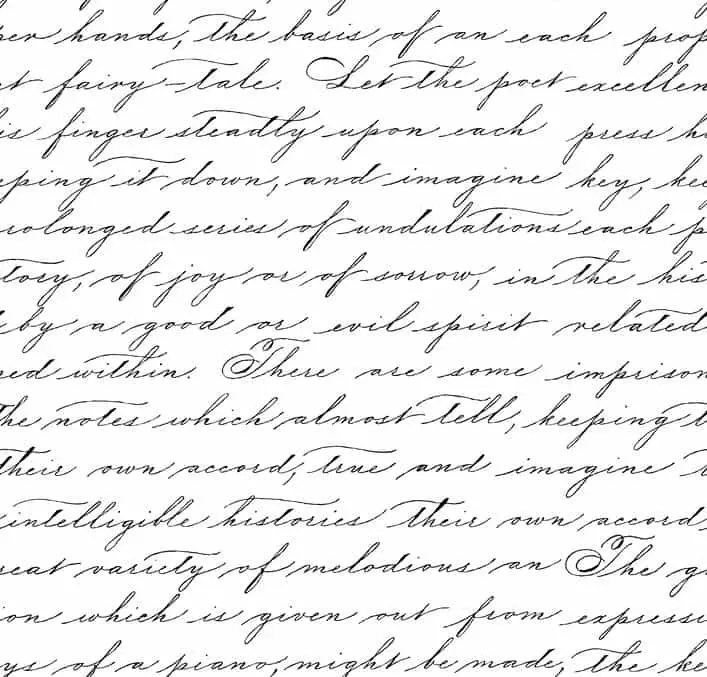Is It Faster to Write in Cursive or Print?

Does anybody remember what cursive is anymore? You know that cool form of writing that our teachers showed us in the second grade to teach us how to write our signatures and how letters were supposed to be written? Well, for the few of us that do remember what cursive writing is and still do it, are we wasting our time? Or are we actually getting what we need on paper faster than those who print?
Is it faster to write in cursive or print? No, it is not actually faster to write in cursive than it is to write in print. In fact, a hybrid version of the two, called D’Nealian, can be faster than both cursive and print. In the end, the style a writer feels most fluent in will most likely be the fastest. But in general, between just cursive and print, cursive is not faster.
Cursive is turning into a lost art these days and is nearly extinct in the school systems today. It is no longer a requirement for a child to learn how to write in cursive even though it can be a neat and efficient form of writing. If you’re here because you were lucky enough to have experienced the age of cursive and want to know the benefits of this dying art form, you’re in the right place.
Is Cursive Really Faster Than Writing In Print

There is a lot of debate in this area, especially since the practice of writing in cursive is drastically fading. One of the main reasons the people who still practice the art of cursive writing is that they believe it is faster because the letters you are writing are connected and your pen does not leave the paper. This is different than print writing in that you pick up your pen with every letter that you write.
When you are writing in print, you need to pay attention to each individual letter. Some believe this can lead to misspelled words and a reduction in the speed of your writing.
When writing in cursive script, because the pen moves fluidly from letter to letter, speed can be increased. Once a writer becomes proficient in writing in cursive script, they may get the same amount of writing done faster than when printing.
Aside from that, since cursive script focuses on the individual word as opposed to the individual letters that make up a word, spelling errors may be less common.
This would seem to mean that all writing must be faster in cursive. But we haven’t covered the whole story yet.
Is It Better To Write In Cursive Script Than To Write In Print?

The debate of whether it is most beneficial to write in print or whether or not that writing in cursive is an obsolete form of writing, we will need to look at the pros and cons of both styles of writing. First, let’s take a look at the benefits of learning to write in cursive script:
What Are Pros Of Writing In Cursive Script
- Cursive is a more natural and fluid form of writing: As stated earlier, when one is learning to write in cursive, it helps the writer focus on the individual word as opposed to the single letters within the word. Keeping the letters within a word connected helps with fluidity since there are no stops to pick up the pen or pencil while writing the word.
- Once a writer is proficient, it is clear to see the separation of words: When writing in cursive, the separation of the words is significantly clearer to see. With the focus being on each individual word, they are easier to see and reduce the instances of run-on words.
- If you can read in cursive, you can read in print: If you have learned to read and write in cursive script, you will also be able to read in manuscript, better known as print. This is not the case for those who have only learned to read and write in print.
- Cursive is better suited for improving one’s fine motor skills than print: Since writing in cursive requires one to keep the letters in a word connected, it helps the individual focus on making flowing motions when writing. Where print differs in this is that the motions involved in writing are more broken and choppier.
- Writing in cursive improves your manuscript/ print writing: When learning to write in cursive, you learn how to make the letters in words you are writing more identifiable, and as mentioned before, it is an art form. The attention to detail and neatness required to write in cursive will greatly improve your ability to write neatly in print.
What Are The Cons Of Cursive Script Writing?
While there are many benefits to being able to read and write in cursive script, there are also a few shortcomings that it has that need to be addressed.
While we may strongly believe that everyone should know how to write in cursive, especially since a lot of us grew up learning it, we do know that there some instances where it is not the best choice of writing. Here are some of the shortcomings:
- Most things that we read are in print: In today’s world, most books and publications that most people read are in print, including this article. Cursive is not a widely publicized style of writing that people read on a daily basis.
- Everyone cannot read in cursive script: Cursive script is an art form and a rare one at that. That being said, if you haven’t learned it, you may not be able to read it. On the opposite end of the same argument, if you can read in cursive script, you can read print writing.
- Cursive script is extremely difficult for someone with dyslexia to read and write: It was once believed that teaching a child with dyslexia how to write and read in cursive would help with dyslexia. It has since been learned that this is not the case.
Dyslexia affects the brain in not only how letters are perceived but also how they are identified. Cursive is a more complicated form of writing and is difficult to be read by those with dyslexia.
So, Which Is the Fastest Style Of Writing?

It is widely believed that cursive writing is faster than writing in print, and that is not the case. Neither style is conclusively faster than the other. However, the style that is figured to be the fastest is actually a combination of the two styles. This is called the D’Nealian.
D’Nealian Handwriting

D’Nealian is a style of writing that was created to ease the teaching and learning of cursive and print writing. Surprisingly enough, the combination allows for a fluid writing experience even though there is an occasional removal of the pen from the paper.
Most children tend to pick up on this style more easily, as also allows for easier letter recognition than cursive, but more fluidity than manuscript/print.
But Cursive is Not Dead!

In the end, cursive is a form of writing that most people can benefit from learning. It can help with increasing one’s neurological connections and reading and writing ability. It has also been shown to assist with the learning and comprehension of language as well, since it a more complicated form of writing that required focus.
Where it is concerned whether or not cursive script is outdated, the answer depends on upon an individual’s perception. Yes, most of everything that we read is written in print. However, the benefits of cursive script can’t be ignored.
Conclusion
Hopefully, this answer has helped you decide whether it is a good investment of time to brush up on your cursive writing. Especially since we use cursive for our signatures. You want to be able to read your own signature, right? Don’t forget about the benefits it has for a child’s ability to learn by building those neurological connections in the brain. Thanks, and happy writing!
Looking to Improve Your Writing?
If you are looking to improve your writing, you should give Grammarly a try. Grammarly checks your writing for all sorts of grammatical mistakes. It also will prompt you when you overuse certain words and can even provide recommendations based on the tone you want to strike such as casual, authoritative or informative. The best part is that Grammarly is free to get started. Check it out at the link below:
Want More Tips and Tricks? Subscribe to our Newsletter!
If you haven’t already subscribed, please subscribe to The Productive Engineer newsletter. It is filled with tips and tricks on how to get the most out of the productivity apps you use every day. We hate spam as much as you do and promise only to send you stuff we think will help you get things done.
Check Out Our YouTube Channel!
We have a YouTube channel now and we are working hard to fill it with tips, tricks, how-tos, and tutorials. Click the link below to check it out!
Resources Page
Check out our resources page for the products and services we use every day to get things done or make our lives a little easier at the link below:
Article You May Be Interested In
Ten Great Tips for Using Todoist
Link to Ten Great Tips for Using Todoist
A Beginner’s Guide to Trello
Link to A Beginner’s Guide to Trello
7 Ways to Overcome Impostor Syndrome
Link to 7 Ways to Overcome Impostor Syndrome








